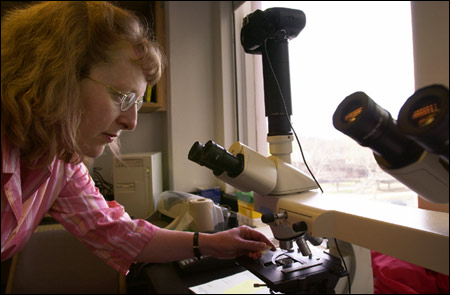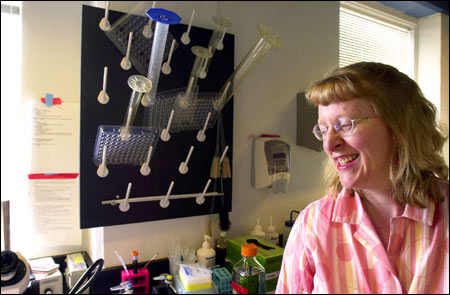Pain produces mystery nerve loss
Mirror-image pain distresses researchers

People who injure an arm or leg sometimes develop pain, swelling, or other unexpected symptoms in the opposite, uninjured arm or leg. Medical reports of such mirror-image effects go back at least to the Civil War and usually are blamed on overuse of the undamaged arm or leg.
Anne Louise Oaklander, director of the Nerve Injury Unit at Massachusetts General Hospital in Boston, saw the glimmering of another explanation while studying patients with nerve damage from shingles. Caused by the virus that produces chicken pox in children, shingles inflicts adults with a painful rash of crusting blisters. It usually occurs on one side of the body. When the rash is treated, the pain goes away for some people, but lingers in others.
Oaklander, who is also an assistant professor of anesthesiology and neurology at Harvard Medical School, removed pinhead-size skin samples that allowed her to count how many nerves are working in small areas of skin. She found dramatic, long-lasting loss of nerve endings in areas previously affected by shingles. That was expected. But when her team checked skin from unaffected areas directly opposite the shingles outbreak, they were startled to see half the nerve endings had been lost there as well.
What is more, the greater the loss of nerves on the unaffected side, the more pain patients felt on the side previously affected with shingles.
Other researchers assumed that the mirror-image damage was due to spread of the virus, which didn’t cause a rash on the other side. But Oaklander and other researchers had found similar mirror-image effects in humans and lab animals who had suffered direct injuries where no viruses were involved. So she decided to investigate further.
Searching for missing nerves
Oaklander and her collaborators carefully cut a branch of the sciatic nerve on one hind paw of a bunch of lab rats. This killed all nerve endings in the cut area. But a few weeks after the surgery they also found that, in the precise spot on the opposite paw, nerves had also died. “That was completely unprecedented,” Oaklander comments.
More than half (54 percent) of the nerves died in the same spot on the uninjured limb, a major loss. After five months, a big part of the 2-year life span of rats, no regrowth of those nerve endings occurred.
Oaklander and her student assistant, Jennifer Brown, describe details of these experiments in the May issue of the Annals of Neurology.
Oaklander also has observed this crossover effect in patients with problems other than shingles. “You see it in all kinds of injuries – cut fingers, sprained ankles, broken legs,” she notes. “We intend to investigate this effect in a more systematic way, and hope that our work will prompt other researchers to do the same. If further investigation reveals now unknown connections between opposite sides of the body, it will have important implications for surgeons, orthopedists, and others involved in treatment and rehabilitation of one-sided injuries.”

Changing the textbooks
What could this mean for the study of anatomy? “For starters, it implies that matching areas on two sides of the body communicate with each other in ways that no one was aware of until now,” Oaklander answers. “There are no known pathways connecting matching sensory nerves on opposite sides of the body.” If such pathways are found by further investigation, changes will have to be made in a lot of textbooks.
Another implication concerns the experiments of researchers around the world who take sides to study the effects of injury or disease. They compare what happens on the diseased or injured side to the mirror-image side, which they believe is normal. “Now, these scientists will have to use other sources for these important comparisons, such as uninjured humans or animals,” Oaklander points out.
Why wasn’t crossover damage found before? “Because scientists and doctors never looked for it,” Oaklander answers. “It doesn’t fit in with our current understanding of how the body works. You don’t see it because you don’t look for it.”
Right now, doctors can’t treat, or lessen, symptoms on the uninjured side because they don’t understand what is happening. In this way, crossover pain is like phantom pain, the stabbing, burning sensation people feel in limbs that are no longer there because of amputation. Are they connected? Oaklander doesn’t know. You can’t examine nerve endings in limbs no longer attached to the body.
One explanation for the yet-to-be-found connections is that they are needed for good health. “It’s most likely that connections we find involved in disease and injury exist for normal coordination between both sides of the body,” Oaklander says.
“Our research provides a discovery, but it doesn’t give us a lot of answers about why things happen the way they do,” Oaklander continues. “It does, however, tell us what questions we need to work on.”
She excuses herself and heads back into her lab to start that work.




